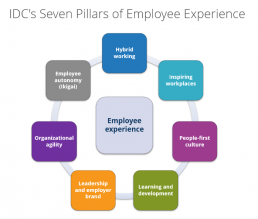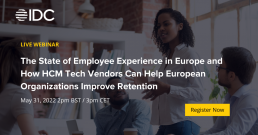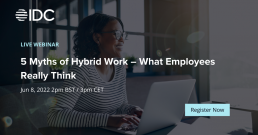European organisations are struggling to retain existing employees and to recruit new staff. The so-called “Great Resignation” in early 2021 demonstrated an alarming disconnect between what employers were offering and what employees actually wanted and experienced. In 2022, potential labour shortages are a top 3 CEO concern worldwide.
How bad is the problem in Europe and what are the roots of this disconnect between employers and employees leading to resignations and the loss of highly valued talent? To shed light on this, IDC asked 2,785 employees across 10 European countries about their employee experience, future of work preferences and propensity to change employer. The results are telling and have clear implications for HR leaders at European employers and human capital management (HCM) tech vendors.
32% of European Employees Are Looking for a New Job — Now
European organisations probably don’t want to know that 32% of their employees are looking for alternative employment right now. And that’s just the average. In some demographics — SMBs, younger employees, financial services — the proportion of active job hunters increases to much higher levels.
Of the 32%, 7% are employees who have been forced to look for new employment due to a change of residence or because they are on time-limited contracts. This leaves 25% of European employees who are looking for new opportunities simply because they are unsatisfied with their current employment.
This is a bigger problem than anyone might have expected. When an employee leaves, it is highly disruptive and expensive for the employer. Studies estimate that the cost of replacing an individual employee can range from a half to two times the employee’s annual salary. The most talented employees often leave first.
Another study shows that the majority of those leaving say their manager or organisation could have done something to prevent them from leaving. In other words, something went wrong in the employee experience.
Employee Retention Requires Good Employee Experience
Better pay is the number 1 reason for employees looking for another job. Some employers might think, “Well, in that case there is nothing I can do.” However, IDC believes that European organisations can significantly improve their compensation practices without simply increasing salaries. Actions that can mitigate some of the pay-related dissatisfaction include:
- More meaningful variable pay and employee goals
- Clearer link between performance and pay
- Better compensation management tooling for managers (comparing employee pay, pay history, linking performance to pay, etc.)
- More accessible pay- and performance-related information for employees
Interestingly, the three other main reasons for looking for another job are related to aspects that employers can potentially improve on: working environment/working experience, career development and flexible working conditions. By improving these, European employers can partially mitigate the employee attrition risk.
A New View on Employee Experience
Employers must get a better handle on employee experience, with a clear need to break this nebulous term into tangible components. IDC offers an actionable “Seven Pillar” model on employee experience — and HCM solution vendors can directly influence and transform six of the seven pillars. Each pillar has a number of organisational change initiatives and desired employee experience outcomes.
IDC’s Future of Work European Employee Survey asked employees to rate these pillars in terms of importance and satisfaction at their current employer. This enables IDC users of this research to understand what pillars matter the most and to pinpoint the main experience shortfalls.
Some of the more cultural- and leadership-related aspects of employee experience are surprisingly important to employees, but these are also the areas where employees on average experience the biggest disappointments with their current employers.
This has a number of implications for vendors of HCM technologies in Europe. Vendors should:
- Position solutions in the context of reducing employee attrition. The survey found that top management and HR have multiple ways to improve employee experience and reduce the risk and impact of employee churn — highlighting how improvements in employee experience strongly reduce the risk of attrition.
- Position solutions as enablers of key action areas, such as compensation, employee experience and flexible working. The survey identified three areas as effective measures to mitigate attrition risks: implementing transparent and consistent compensation, improving the employee experience for all employees (not just office employees and knowledge workers) and evolving flexible working policies.
- Emphasise how employee retention and substandard employee experience is a problem for all organisations and all employee types. Some people assume that employee churn is mostly a knowledge worker issue and something that only large organisations must deal with. However, the survey found that employee experience is important to all types of employees, that employee attrition affects all types of employees and that it is particularly hurting small and midsize organisations in Europe.
Upcoming free webcasts:
Employee Experience in Europe – How European HCM Tech Vendors Can Help European Organizations Improve Retention, we will address the following questions:
- What were some of the eye-opening findings in this recent, landmark European employee survey?
- Why is employee churn such as big deal?
- What is employee experience and what did we learn from the survey about it?
- How can HR departments and HCM tech vendors best influence employee experience?
5 Myths of Hybrid Work – What Employees Really Think:
This webcast, aimed at leadership teams (CEO, CFO, CHRO, COO), will help you to understand how to enable more effective hybrid work models. Additionally, you will learn how to understand real employee sentiment as opposed to using myths as a base for decision making as you transition to hybrid.
For further information on European Human Capital Management Applications and Employee Experience research, please contact Bo Lykkegaard or Ivan Oz. or drop us a message at https://www.idc.com/eu




